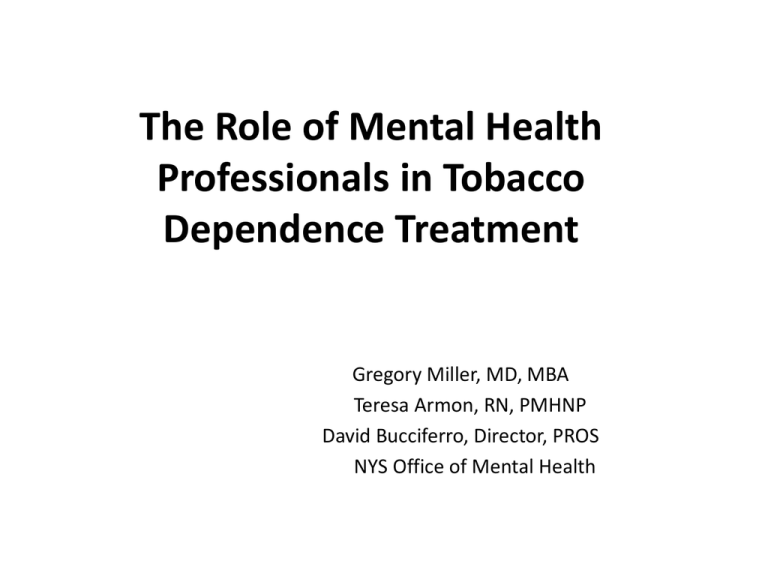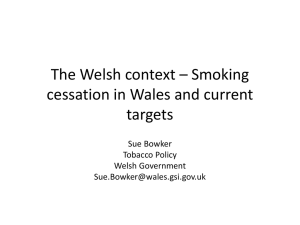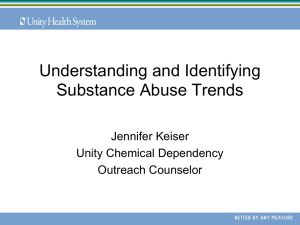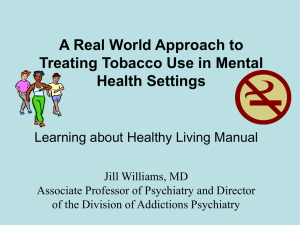Downloads - NYS Smokers` Quitline
advertisement

The Role of Mental Health Professionals in Tobacco Dependence Treatment Gregory Miller, MD, MBA Teresa Armon, RN, PMHNP David Bucciferro, Director, PROS NYS Office of Mental Health Learning Objectives 1. Describe the epidemiology of tobacco use and dependence in people with serious mental illness (SMI). 2. Describe the NYS Partnership, the goals to reduce tobacco use in people with SMI and strategies utilized to achieve this goal. 3. Discuss specific evidence based interventions of assessment and treatment of tobacco dependence for people with SMI: pharmacotherapy and counseling. 4. Discuss the importance of wellness and tobacco dependence treatment to a person's mental health recovery. 5. Describe how wellness and tobacco dependence treatment services are part of mental health treatment, specifically in Personalized Recovery Oriented Services (PROS). Disclosure Statement We have no real or perceived vested interests that relate to this presentation nor do we have any relationships with pharmaceutical companies, and/or other corporations whose products or services are related to pertinent therapeutic areas. Overview of Tobacco Use in People with SMI Why should we become involved? • • • • • • • • • • Saves lives Saves healthcare dollars Improves productivity Nicotine Dependence is a DSM-IV Disorder Disproportionate in the mental health population Tobacco dependence and mental illness are co-occurring disorders Behavioral practitioners practice psycho-social treatments Tobacco interferes with psychiatric medications Consistent with wellness and recovery approaches Reimbursement for treatment is improving Williams, MD and Zeidonis, MD 2006 Why Should We Become Involved? About ½ of all cigarettes smoked in the USA--are smoked by someone with SMI and/or Substance Use Disorder!!!! SMI-Reduced Life Expectancy • 20% shorter life span • Poor health care • Increased coronary heart disease largely smoking related (remains when controlled for weight/bmi) goff 2005 • Increased mortality rates (above general population) – Cardiovascular disease – Respiratory disease – Cancer 2.3 x 3.2 x 3.0 x Brown 2000; Davidson 2001; Allison 1999; Dixon 1999; Herran 2000 Schizophrenia and Smoking • Very high prevalence: 80% (65-85) • Smoke more – quantity of cigarettes – amount of draw per cigarette • • • • Smoking topography studies Half as successful in quit attempts Smoking produces therapeutic benefit Smoking ameliorates medication side effects Jill Williams: Tobacco Dependence in Mental Health Settings Quit Attempts in Total Population • About 2/3 of all current smokers have tried to quit • Majority of quit attempts, whether or not successful, occur without organized assistance • Evidence supports that more nicotine dependent/ multiple relapses may respond better to organized cessation – Even though people with SMI want to quit, they engage in quit attempts less often – When they do, they are about ½ or less as likely as others to have a successful quit attempt Tobacco Dependence and Mental Health Care • Traditionally permissive attitude – Tobacco has traditionally been a reward in mental health settings – Management incentive on Inpatient units – Nicotine Dependence: most common substance abuse disorder among individuals with schizophrenia • Higher rates of smoking in mental health providers and psychiatrists than other health professionals Current Smokers by Mental Illness History Lasser, et.al. 2000 None, 23% Ill during past month, 42% Ever Ill, 35% Who owns the problem? • Mental health population represents a wide spectrum • Smoking has a high prevalence across the continuum (Only 22% of smokers have not had a diagnosable mental illness) • Common factor: high prevalence of desire to quit across the population • However: not all segments of the mental health population are equally successful with traditional quit-smoking interventions New York State Action Plan New York State Leadership Academy for Wellness and Smoking Cessation • New York is the first of five states to hold Leadership Academies. • Supported by the SAMHSA and the UCSF Smoking Cessation Leadership Center (SCLC) • The New York State summit is a model for future collaborations bridging public health and behavioral health. Participation: 30 partners from a wide variety of backgrounds: • Mental Health Leaders, Researchers and Providers • Public Health Leaders • Addiction Professionals • Consumers • State Agencies • Tobacco Prevention Experts SCLC SAMHSA Partnership • Leadership Academies for Wellness and Smoking Cessation – Reduce smoking and nicotine addiction among behavioral health consumers and staff – Create partnership among public health (including tobacco cessation), mental health, and substance use prevention and treatment that will serve to improve wellness among behavioral health consumers New York is the first state (of 5) of the Leadership Academies for Wellness and Smoking Cessation Baseline Data and Goal of Partners Currently in New York State: • 30% of people with serious mental illnesses smoke • 50% of people with mental illness and substance use disorders smoke • The goal of the summit partners: reduce smoking prevalence by 10% in each of these groups by 2015. • Focus on “Early Adopters” who are leading the way with Smoking Cessation in people with SMI so that we might highlight their efforts and share with other programs Overarching strategies to reach this goal 1. Peer Support and Recipient Engagement 2. Medicaid and Managed Care Utilization and Expansion of Benefits 3. Improved Tobacco Cessation through Policy, Certification, and Regulation 4. Training and Dissemination Workgroups • Workgroup for each strategy – open to new members • Monthly workgroup conference calls • ListServ • Membership has increased to include – NYAPRS – Peer-run program – Curriculum reviewers Peer Support • Peer driven / Wellness integrated approaches have proven effective: allows person to talk to someone who knows about quitting smoking • Rx for Change for Peers training, CHOICES • Encourage the development of support groups and peer specialists (Buffalo PC) • NYAPRS – consumer forum at Fall conference • Designed Tobacco related questions as part of Consumer Questionnaire Medicaid and Managed Care Utilization and Expansion of Benefits • In collaboration with NYS DOH, crafted proposal to expand benefit of NRT • Educate consumers and providers and encourage use of current Medicaid benefit for Smoking Cessation: Covered agents include nasal sprays, inhalers, Zyban (bupropion), Chantix (varenicline), over-the-counter nicotine patches and gum. Two courses of smoking cessation therapy per recipient, per year are allowed. A course of therapy is defined as no more than a 90-day supply (an original order and two refills) Improved Tobacco Cessation through Policy, Certification, and Regulation • Change licensing/regulation to improve detection and treatment of smoking • Use of clinic licensing and PROS licensing standards to drive inclusion of tobacco dependence treatment • Integrate smoking treatment into IDDT requirements • Adopt new standards for licensing of mental health programs to include tobacco-related criteria Evidence Based Training and Dissemination • Web-based education targeting tobacco cessation incorporated into FIT (Focus on Integrated Treatment) training program • Tobacco dependence treatment learning modules • Evidence based and easily accessible training as part of Integrated Dual Diagnosis Treatment (IDDT) • Similar approach as to that of substance and alcohol use in people with SMI (e.g. motivational interviewing strategies, stages of change) Focus on Integrated Treatment Center for Practice Innovations at Columbia Psychiatry http://www.practiceinnovations.org PROS Tobacco Dependence Treatment Services: Pharmacology Basics It’s the Smoke that Kills Cigarette smoke > 4000 compounds Acetone, Cyanide, Carbon Monoxide, Formaldehyde >60 Carcinogens Benzene, Nitrosamines (CDC This Slide Courtesy of Jill Williams, MD UMDNJ 2003) Medication for Tobacco Dependence • First-line Tobacco Dependence Medications (FDA Approved) – Nicotine Replacement • Gum, lozenge, inhalers, spray, patch, – Bupropion (Zyban; Welbutrin) – Varenicline (Chantix) Myth Busting about Nicotine Replacement • • • • • • • • Nicotine is not a carcinogen Patients tend to self dose Scheduled is better than PRN Period of treatment: may be crucial factor in SMI OK to combine with bupropion OK to combine with each other Very few contraindications Little to no drug-drug interactions Jill Williams: Tobacco Dependence in Mental Health Settings More myth busting regarding NRT • Nicotine and patients with MI / Cardiac Disease – No reason not to use – Not introducing a “new drug” – Safer nicotine delivery vs smoking Jill Williams: Tobacco Dependence Treatment in Mental Health Settings Westman/ Schiff, 2010 based on Cochrane Review Data SMI and Tobacco Dependence • Tobacco Dependence Medications must be part of the psychopharmacologic treatment plan – Consideration of the need to deviate from “standard” treatment – How and why (logic of plan) – Thoughts about next steps – Cost benefit considerations – Important aspect of plan whether or not prescribing is done by the psychiatrist or by primary care – Difficult to quit patients need focused and aggressive treatment planning around smoking dependence treatment Pros Tobacco Dependence Treatment Services: Assessment and Counseling 2008 Tobacco Dependence Clinical Practice Guideline • “All smokers with psychiatric disorders, including substance use disorders, should be offered tobacco dependence treatment, and clinicians must overcome their reluctance to treat this population” (Fiore et al., 2008, p. 154). 33 PROS • • • • • • Focus on Recovery Strength-Based Approach Program Design: Groups Staff Skills and Competency IRP Documentation 35 Specific treatment strategies for CRS and IR component: • Assess individuals for tobacco dependence. – Stages of Change – Fagerstrom Test for Nicotine dependence (FTND). • Document nicotine dependence on IRP. • Educate individual about tobacco, which contains nicotine and that when smoked is highly addictive. • Motivational interviewing to assist consumer who is in precontemplative stage. • Wellness group to include tobacco dependence, as well as developing other healthy lifestyle behavior. Stages of Change Precontemplation: No plans to quit Contemplation: Considering a quit attempt Preparation: Planning a quit attempt Action: Engaged in quit attempt Maintenance: Relapse prevention Fagerstrom test for Nicotine Dependence • The assessment tool is included in the linked article, “Assessing Nicotine Dependence,” by Terry Rustin, MD. • http://www.aafp.org/afp/20000801/579.html Wellness and Health Education Interventions should address both clients’ misconceptions regarding tobacco use and realistic fears about quitting, including: • nicotine withdrawal • relapse of mental illness • weight gain • People with SMI are have elevated risk for metabolic syndrome • Crucial to focus on healthier life-styles, including good nutrition and exercise, simultaneously with tobacco cessation. Education and Treatment • Interventions should address both clients’ misconceptions regarding tobacco use and realistic fears about quitting, including weight gain and withdrawal. • Persons with mental illnesses are at heightened risk for obesity and the metabolic syndrome because of side affects of psychiatric medications as well as physical inactivity. • They must learn healthy coping strategies, including good nutrition and exercise (may need referral to PCP for evaluation before changing diet or starting exercise). Support Client The greatest chance the clinician has to aid the client who does not want to stop smoking at the present, but is open to consider quitting at some point in the future, is to not pressure her while letting her know you are always willing to help if she ever decides differently. Client who has Considered but Not Ready to Quit • Identify potential negative consequences of tobacco use. highlighting those that seem most relevant to the client • Encourage the person to speak specifically about why quitting is relevant to him or her • Highlight benefits of stopping tobacco use. • The clinician should ask the patient to identify potential benefits of stopping tobacco use. • UMDNJ: “I’m not ready to quit smoking but I am ready to” – List For IDDT service in IR • Engage individual in an EBP intervention to treat tobacco dependence, which includes pharmacotherapy and cognitive behavioral treatment. • Staff trained in tobacco dependence treatment interventions for people with serious mental illness. • Medication and symptom management as part of Clinical Treatment. Counseling Strategies: Intensive Interventions The same interventions that help the general population are likely to help people with SMI if provided at greater intensity and for longer periods of time Intensive Treatment • A general rule regarding smoking cessation efforts is that more is better. • More intensive treatment frequency and increased duration lead to greater quit rates. • Multiple types of clinicians are effective in delivering tobacco treatment, and involving more than one type of provider leads to greater success. Counseling Strategies: Intensive Counseling • • • • Higher intensity Session length > 10 minutes 4 or more sessions, often exceed 8 sessions Tend to be coordinated by tobacco dependence specialists • Multiple clinicians, best when coordinated care Intensive Treatment Keep it Person- Centered • • • • • Individual interventions Treatment groups Motivational interviewing Problem-solving and skills training Cognitive Behavioral Therapy (CBT) Person Centered • If you are losing your own motivation to deliver tobacco dependence intervention, seek consultation with a colleague so that you can once again utilize the energy of your self to work creatively and collaboratively with your clients • Colleagues, supervisors, administrators need to support the tobacco dependence program and the clients and staff – must have buy-in Peer Support • CHOICES (Consumers Helping Others Improve their Condition by Ending Smoking) Program – Consumer-driven peer outreach program which employs mental health peer counselors, called “consumer tobacco advocates” (CTAs) to serve as tobacco-focused consultants to consumers and mental health agencies – http://njchoices.org/ – – – – Consumer Advocates Quit Tips Art and Poetry Support Individualized Recovery Planning • Values: – Person-centered – In the individual's voice – Recovery-focused • Documentation involves: – conducting a series of Assessments – developing an Individual Recovery Plan (including Relapse Prevention Plan) Individualized Recovery Plan • Nicotine Dependence should be included as DSM IV diagnosis • An individualized plan as part of client’s life goals to include tobacco dependence treatment • Hope to advance toward less smoking • Important aspect of plan whether or not prescribing is done by the psychiatrist or by primary care • Monitoring for nicotine withdrawal and symptoms of psychiatric illness (Medication may need adjustment when quit smoking) • Support systems: staff, peers friends and family “Learning About Healthy Living” • The aim of this treatment manual is to provide a format to address tobacco for smokers with a serious mental illness who are either prepared to quit smoking or who are simply contemplating quitting in the future. • This manual has been developed with input from mental health consumers and treatment staff. • The manual was designed to give the consumer information about the recovery process from tobacco addiction, including educating them about the treatment. • Facilitator and consumer handouts “Learning About Healthy Living” • Mental Health provider can adapt a program designed for tobacco users with all types of mental health problems. • Learning About Healthy Living: Tobacco and You is a two-part course offering education and support for healthy choices. • The first part (Group I) for people with mental illness whether they are ready to quit smoking or not, is structured around 20 topics • Group 1 teaches about the impacts of tobacco use, but also educates consumers about healthy diet, activity, and stress management. • Those who complete the first series of sessions and want to quit smoking can participate in an eight- to ten-week actionbased program to learn to quit. Toolkits/Resources • Developed by experts who have done research on Smoking in People with Serious Mental Illness • Consumer Input • Easily available to programs • No one approach – review all resources and be open to hearing about other models Acknowledgements and Toolkits • Smoking Cessation Leadership Center http://smokingcessationleadership.ucsf.edu • Rx for Change http://rxforchange.ucsf.edu Psychiatry Curriculum Mental Health Peer Counselor Curriculum • UMDNJ Learning About Healthy Living Manual http://ubhc.umdnj.edu/nav/LearningAboutHealthyLiving.pdf • APNA Tobacco Dependence Intervention Manual for Nurses http://www.apna.org/files/public/TobaccoDependenceManualforNurses.pdf • University of Colorado Smoking Cessation in People with mental Illnesses http://smokingcessationleadership.ucsf.edu/Downloads/catolgue/MHtoolkitJan_2009.pdf • NASMHPD Tobacco-Free Living in Psychiatric Settings http://www.nasmhpd.org/general_files/publications/NASMHPD.toolkit.FINAL.pdf • OMH Wellness Initiative: LifeSPAN http://www.omh.state.ny.us/omhweb/adults/wellness/lifespan/smoking_cessation/ References • • • • • • • • • Cataldo , J. A (2001) The Role of Advanced Practice Psychiatric Nurses in Treating Tobacco Use and Dependence . Archives of Psychiatric Nursing, Vol. XV, No. 3 (June), 2001: pp 107-119 Diagnostic and Statistical Manual of Mental Disorders DSM-IV-TR Fourth Edition (1994) Fiore, M. C., Jaén, C. R., Baker, T. B., Bailey, W. C., Benowitz, N. L., Curry, S. J., et al. (2008). Treating tobacco use and dependence: 2008 update. Clinical practice guideline. Rockville, MD: U. S. Department of Health and Human Services. http://www.surgeongeneral.gov/tobacco/treating_tobacco_use08.pdf Grant BF, Hasin DS, Chou SP, Stinson FS, Dawson DA. (2004.). Nicotine dependence and psychiatric disorders in the United States; results from the National Epidemiologic Survey on Alcohol and Related Conditions. Arch. Gen. Psychiatry 61(11), 1107–15. Krejci, J, Foulds, J. (2003)/ Engaging patients in tobacco dependence treatment: assessment and motivational techniques. Psychiatric annals. 33:7, 438-444. Lasser K, Boyd J.W., Woolhandler S., Himmelstein D.U., McCormick D., Bor D.H.,(2000). Smoking and mental illness: a population-based prevalence study. JAMA, 284 (20), 2606–10. Miller, WR, Rolnick, S (2002). Motivational Interviewing : preparing people for changes. 2nd edition. New York: Guilford press. 2-1-216. Morris C.D., Giese, J.J., Dickinson, M., Johnson-Nagel N. (2006). Predictors of tobacco use among persons with mental illnesses in a statewide population. Psychiatric Services, 57(7), 1035-1038. National Institute on Drug Abuse. (2006). Section VI: Treatment of Nicotine Dependence Hughes, J and Fagerstrom, K. Interventions for treatment-resistant smokers. References • • • • • • • • • • Prochaska, J. “Smoking and Mental Illness-Breaking the Link”, July 14, 2011, JAMA, Prochaska JO, DiClemente CC. 1982. Transtheoretical therapy: toward a more integrative model of change. Psychother. Theory Res. Pract. 19(3):276–88 Prochaska, J., Hall, S. Sharon M. (2009), Treatment of Smokers with Co-Occurring Disorders: Emphasis on Integration in Mental Health and Addiction Treatment Settings Annu Rev Clin Psychol. 2009 ; 5: 409–431. Schroeder S.A., Morris, C.D. (2010). Confronting a neglected epidemic: tobacco cessation for persons with mental illness and substance abuse problems. Annu. Rev. Public Health 31(1), 16-18 Steinberg, M.L., Williams, J.M. & Ziedonis, D.M. (2004).Financial implications of cigarette smoking among individuals with schizophrenia. Tobacco Control 13(2),206. Weinberger, A.H. et al (2007). Reliability of Fagerstrom Test for Nicotine Dependence, Minnesota Withdrawal Scale, and Tiffany Questionnaire for Smoking Urges in Smokers with and without Schizophrenia. Drug and Alcohol Dependence 86 (2007) 278–282. Williams JM, Ziedonis D. (2004). Addressing tobacco among individuals with a mental illness or an addiction. Addict. Behav. 29(6),1067–83. Williams JM & Ziedonis DM. (2006). Snuffing out tobacco dependence: Ten reasons behavioral health providers need to be involved. Behavioral Healthcare. 26(5), 27-31. http://www.cancer.org/ American Cancer Society THANK YOU! Gregory.Miller@omh.ny.gov Teresa.Armon@omh.ny.gov David.Bucciferro@omh.ny.gov







